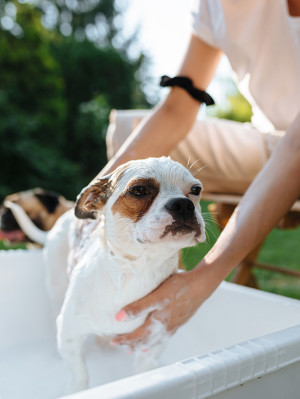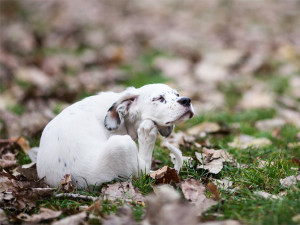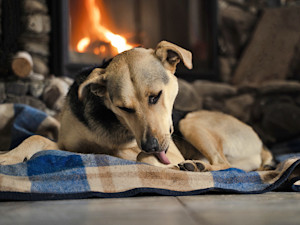Home Remedies for Hot Spots
Your dog’s most annoying problem of the week — solved.

Share Article
In This Article:
What Are Hot Spots? What Causes Hot Spots? How to Prevent Hot Spots When to See a Vet What Are Some Home Remedies? Topical Treatments Dietary Adjustments Other Remedies Tips for Using Home Remedies Safely
If your dog has ever suffered from a hot spot, you know how miserable and scary these patches of inflamed skin can initially look. Hot spots come in many varieties, with some being more superficial and mild, while others can be deep and severe.
When treating a hot spot, there are a few underlying principles to keep in mind. First, treatments should aim to dry out the skin and reduce moisture around the hot spot. Second, you need to work to improve your dog’s overall discomfort, which may include reducing pain, itchiness, and/or underlying conditions that initiated the irritation.
Next, you should take steps to stop them from licking and chewing at the area. Finally, if their symptoms cannot be controlled with at-home remedies, be sure to see your vet right away to ensure there is not another cause for their skin problem and/or a need for prescription medical treatments.

Main takeaways
Hot spots are areas of moist, inflamed skin caused by a dog repeatedly licking and chewing at one specific spot
There is always an underlying cause for a hot spot, such as an itchy or painful condition that leads a dog to lick and chew at their skin.
Treatment requires relieving the underlying itch or painful condition, and treating the damage to the skin. If you catch the condition early, you can try some home remedies.
It is very important to seek veterinary care for this condition if you are unsure what the underlying cause is, when a hot spot is severe (infected and painful), or if it’s getting worse.
What are hot spots?
Hot spots on dogs are areas of the skin that become red and inflamed as a result of your dog licking and chewing at the area. Technically referred to as acute moist dermatitis or pyotraumatic dermatitis, they can vary in their appearance and underlying causes.
This condition starts with an initial irritation or pain that leads your pup to start licking or chewing at their skin. This self-trauma creates a focal area of hair loss with red, moist, irritated skin that may be raw, oozing, and/or scabbed over. These wounds are often painful, and dogs may shy away from having them touched. Once the skin has been damaged in this way, it’s very susceptible to a secondary infection — so, many hot spots also become infected.
What causes hot spots?
Hot spots are caused by a combination of factors. First, something irritates your pup’s skin such as various allergies, exposure to fleas, a skin infection, or a painful injury. Then, your dog starts obsessively licking and chewing at that area, in an attempt to relieve the itch or pain. The result is that all of that licking and chewing causes the skin to become moist and further inflamed, damaging the skin even more and leading to additional discomfort. It’s a vicious cycle that makes dogs want to lick even more. Hot spots are also more common in warm, humid weather and in certain breeds of dogs with thick coats.
How to prevent hot spots
The best way to prevent hot spots is to quickly identify and treat the underlying conditions that are leading your dog to chew or lick at their skin, before they do too much damage.
Keep your dog on year-round flea preventatives to prevent flea bites, which can be very itchy. If you notice signs of allergies in your dog, consult with your vet, and get your pup on an effective treatment plan to control their itch. If your dog has a painful injury or seems to be licking one spot on their body a whole lot, see your vet to get their pain managed effectively. In the short term, you can also use barriers such as a cone, shirt, booties, or other dog clothing to block your dog from licking that area while you are waiting to see your vet.
When to see a vet for hot spots
While some treatments can be initiated at home, it’s very important to consult your vet if your dog has a hot spot. This is the best way to figure out what caused their hot spot in the first place and bring them relief for that underlying itchy or painful condition. It is especially important to see a vet if your dog seems to be in a lot of pain, has signs of an infection (such as pus or a bad odor coming from the wound), or experiences any additional changes in their health or behavior. Often, prescription medications are necessary to cure hot spots that are more severe and/or infected and to treat their underlying causes.
What are some home remedies for hot spots?
Many purported home remedies for dog hot spots are neither safe nor effective, so it’s important to check with your vet before attempting to treat this condition at home. There are also many other medical conditions that may resemble a hot spot, but require very different treatments. If you are not sure what’s up with your pup, have your vet conduct a thorough physical exam and make a diagnosis before you use any at-home treatments.
That said, hot spots that are identified early may respond well to basic home treatment, and it’s worth a try if you can get the condition under control before it gets worse. The best things you can do at home to treat a hot spot are to keep the area clean and dry, soothe any itch or pain, and block your dog from licking that area while it is healing.
Topical treatments
This is usually the first step in treating a hot spot. Since these areas tend to be very moist from a dog’s overzealous licking, anything you can do to keep the area clean and dry will help it heal. Ideally, their fur should be trimmed or clipped away to remove any matted or moist fur, and to allow the skin to be exposed to air. Then, the skin should be gently cleaned using cool water. Applying a cold compress to the skin, such as a moistened towel, can be soothing and help to reduce swelling, inflammation, and itchiness. The following are other topical products you may hear about for treating hot spots.
Aloe vera gel
This extract from the aloe vera plant can be soothing to the skin. Some studies suggest it may have antimicrobial and wound-healing properties, though this is still being researched. There are a lot of variations between aloe vera products: This is based on how the gel is extracted from the plant and depends on which preservatives are mixed into the final product.
Aloe vera can cause local irritation of the skin in some dogs and may also cause diarrhea if ingested by your pup. Be sure to try this on an area of healthy skin first, to see if your dog can tolerate it — and always prevent your dog from licking or ingesting the gel. Avoid using this product on broken or bleeding skin.
Chamomile tea compress
Many teas contain tannic acids, which are believed to help soothe itchy skin. Chamomile in particularopens in new tab has been used traditionally for its perceived antimicrobial benefits, as well as its anti-inflammatory and antioxidant effects. It may work best to apply cooled tea bags directly to the affected area, or you can use a concentrated brewed tea that has been cooled and dab it onto the skin. Always double-check that the tea is cool before using, and don’t apply it to any open wounds.
Calendula cream
Calendula is an extract from the flower of the pot marigold. It has been used for centuries in traditional medicineopens in new tab to treat minor wounds and mild skin irritation. It may provide some benefits in soothing skin and would best be used at the earliest stage of irritation, before there is too much moisture or any broken skin. Hot spots need to dry out, so using a calendula cream is not recommended once the area has become moist. There may be other products containing calendula that are more helpful at that stage. Always check the ingredient list to ensure there is nothing that could be toxic to dogs in the product, and avoid any alcohol-based products that will sting if applied to open, raw skin.
Topical hydrocortisone cream and/or antibacterial ointment
In contrast to the above treatments, these are not recommended home remedies for hot spots. Although steroids such as hydrocortisone are sometimes used to treat hot spots, they should only be used with veterinary supervision. This is because they can have a lot of unwanted side effects that can do more harm than good, especially if your dog unintentionally ingests the cream. Antibacterial ointments are also not used to treat hot spots, because ointments keep the skin too moist and prevent these wounds from drying out and healing.
Dietary adjustments
You can support wound healing and healthy skin through your dog’s diet and with supplements. This is especially important if you suspect your dog has a chronic skin condition (like allergies), in which their skin is always inflamed and itchy. Some dogs with allergies will need a complete diet change to avoid food allergens. This requires veterinary consultation to ensure they are on an appropriate long-term diet. In addition, the following supplements may help support healthy skin.
Omega 3 fatty acids
Essential fatty acid supplements (including fish oil products) help support healthy skin and coats. These compounds also reduce inflammation, which can relieve the underlying itchy and/or painful conditions that lead to hot spots.
Probiotics
Probiotic supplements provide beneficial microbes that serve many important roles in a dog’s body. They are most well-known for their benefits to the digestive tract, but they also colonize the skin and can help prevent secondary infections and strengthen the immune system. Be sure to use a dog-specific probiotic, because they contain different microbes than human probiotics.
Other remedies
Epsom salt bath
Epsom salts are made of magnesium sulfate and reduce swelling by drawing out moisture. This is best used on areas of the skin with mild swelling that can be easily soaked, like the feet. That said, Epsom salts are not typically used to treat hot spots, because they do not reduce itching or heal the skin.
The Elizabethan collar (aka a cone)
This may not be nearly as cool as some of the other treatments here, but the cone serves a critical role in mending your dog’s hot spot. The pup must stop licking the area in order for the skin to dry out and heal. Nowadays, with many styles available, you can get a little more creative than the basic plastic cone. Just make sure the fit is correct, and that your pup cannot sneak around it to lick their wounds.
Tips for using home remedies safely
There are many steps you can take at home to help soothe your dog’s hot spot and get them on track to heal. It’s important to keep a close eye on the skin and see your vet if you notice signs that the hot spot is getting worse. These signs include pain, a bad odor, discharge from the skin, redness and/or any signs of systemic illness (like lethargy), not eating, bouts of vomiting, diarrhea, or difficulty breathing. You should also see your vet if the skin is not improving after a few days of home treatments, because some hot spots will require more advanced treatment and/or prescription medications.
Here are some tips to keep in mind for home treatments.
Always test the remedy on a small area of your dog’s healthy skin before using it over a larger area or an area with damaged skin. Watch for signs of irritation, and discontinue right away if they occur.
Avoid using home remedies on broken skin or open wounds.
Avoid alcohol-based products, which will cause pain and stinging if applied to irritated skin.
Refrain from using petroleum-based ointments and creams, which will keep the skin too moist.
Address your dog’s underlying reasons for being itchy or in pain. These are motivating them to lick and chew, and may lead to a recurrence of the hot spot if not treated.
If your dog’s hot spot does not improve (or worsens) after a few days of using a home remedy, see a vet.
Bottom line
Hot spots are caused by a complex cycle of itch, pain, and self-trauma from dogs licking obsessively at one part of their body.
To treat a hot spot, all aspects need to be addressed, including the underlying condition as well as the injury to the skin.
Some home remedies can bring your dog relief, but severe hot spots require veterinary intervention.
FAQs
Are hot spots contagious? Can they spread to other dogs or animals?
Hot spots themselves are not contagious. However, some of the underlying conditions causing them could be contagious, such as fleas and other skin conditions.
When should I see a veterinarian for hot spots?
If you are unsure if your dog’s condition is a hot spot, see a vet first to get an accurate diagnosis. If you are attempting to treat a hot spot at home and it worsens after a few days — or if you notice more serious signs such as discharge, a bad odor, and/or a painful reaction from your dog — see a vet right away.
Does Benadryl help with hot spots on dogs?
Benadryl, an antihistamine, will not cure a hot spot, however it can reduce itchiness for some dogs. Because it may relieve itchiness, it might prevent a hot spot if used early on. But this medication is not safe or effective for all dogs, so consult a vet before giving it to your dog.
Can you put Neosporin on a dog’s hot spot?
Neosporin is not recommended for hot spots, and you should talk to your vet before using this antibiotic ointment. Although some topical products with antimicrobials may help to prevent secondary infections, petroleum-based ointments keep the skin moist and may delay wound healing. Many of these products can also be toxic if ingested by your dog, so it’s very important to prevent them from licking the area where you’ve applied these products. More severe cases may require oral antibiotics, so if you are concerned that your dog’s hot spot is infected, consult your vet right away.
References
“Aloe veraopens in new tab.” ASPCA Animal Poison Control. 2024.
Brooks, Wendy. “Hot spots (pyotraumatic dermatitis) in dogs and cats.opens in new tab” Veterinary Partner, 12 November 2024.
Nicolaus, Christoph, et al. “In vitro studies to evaluate the wound healing properties of Calendula officinalis extracts.” Journal of Ethnopharmacologyopens in new tab, vol. 194, 20 January 2017, pp. 94-103.
Sah, Amit, et al. “A Comprehensive Study of Therapeutic Applications of Chamomile.” Pharmaceuticals, vol. 15, no. 10, 19 October 2022, pp. 1284.

Dr. Amy Fox, DVM
Amy Fox, DVM is a small animal veterinarian in New York City with over thirteen years of experience in a mixture of general practice, emergency medicine, and shelter medicine. A lifelong animal lover, Dr. Fox studied biology in college and then worked as a veterinary nurse before pursuing veterinary school at Cornell University. Her expertise includes surgery, dentistry, and management of chronic conditions, and she is interested in toxicology, pain management, nutrition, care of senior pets, and educational outreach. Dr. Fox also enjoys writing about veterinary medicine and teaching, and her work has previously appeared in Spruce Pets. In her free time, she loves to cook, garden, go for long runs, and hang out with her goofy mixed-breed dog May, who provides never ending comic relief!
Related articles
![Brown terrier dog scratching its ear outdoors]()
Relief for Your Dog: Discover Effective Solutions for Their Seasonal Allergies
A vet explains why environmental allergies flare up and what to do about it.
![Little dog getting showered by his owner in the backyard.]()
How to Treat Dog Skin Diseases at Home
And how you might safely give your pup immediate relief.
![Black puppy itches behind her ear due to flea allergy]()
Shoo, Flea: What to Do About Your Dog’s Disturbing Flea Allergy
Before you say “ewww” Moira Rose-style, learn these steps to prevent and remove fleas.
![A dog scratching itself among the leaves outside.]()
Immunotherapy Can Be the Solve For Your Dog’s Allergies
If allergens were to ask, “Am I the drama?,” the answer would be yes.
![a Chihuahua dog licking their paw]()
Why Do Dogs Lick Their Paws?
Their toes might smell like Fritos, but there’s no way they taste that good.
![Dog licking its paw inside by the fire.]()
Hot Spots in Dogs: What Are They, How to Treat Them, and How They Compare to Ringworm
From home treatments to holistic methods—and when to call a vet.







